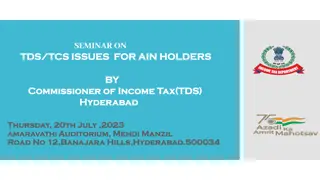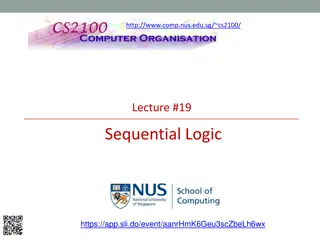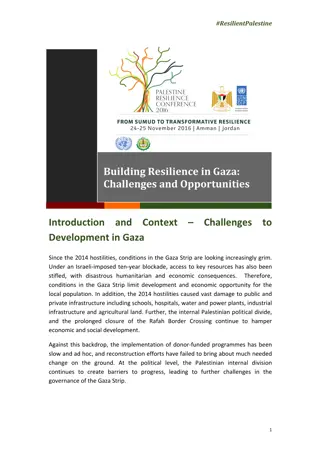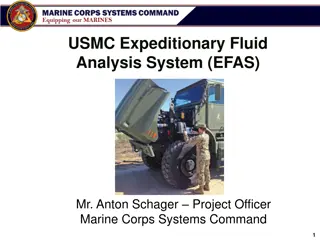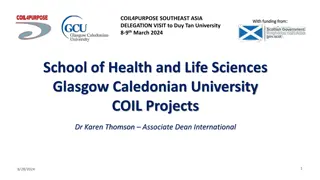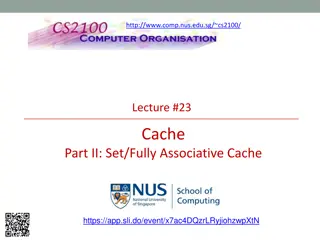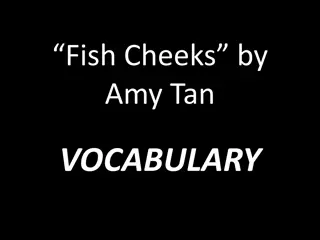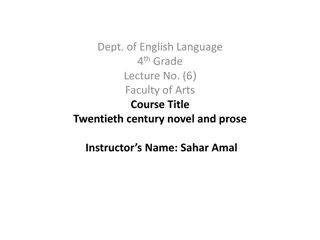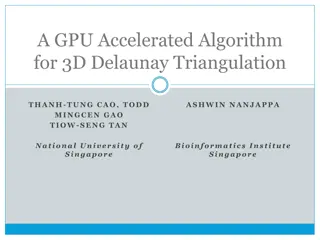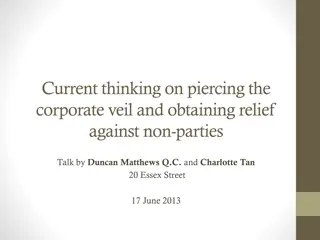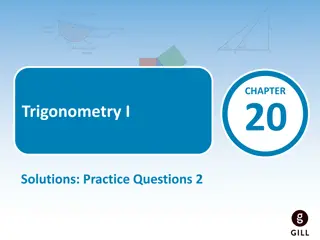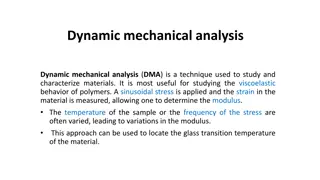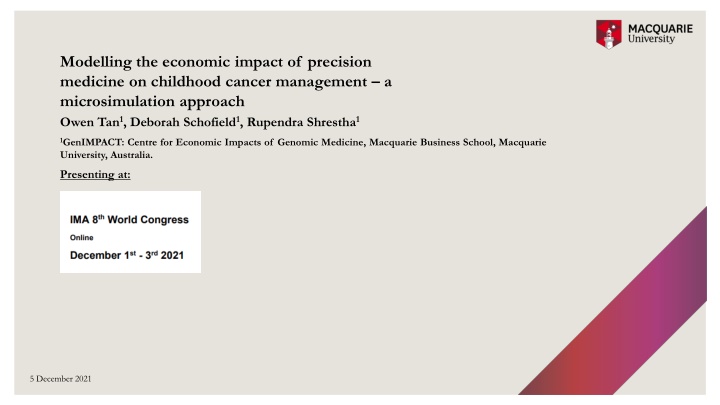
Economic Impact of Precision Medicine on Childhood Cancer Management
Explore the economic impact of precision medicine on childhood cancer management through a microsimulation approach. Genomic-guided precision medicine offers a paradigm shift in treatment strategies, potentially improving outcomes and reducing side effects. Cost-effectiveness analysis is crucial for public funding, with previous studies highlighting the potential benefits and cost-effectiveness of precision medicine in various cancer types. However, there is a lack of studies focusing on the cost-effectiveness of precision medicine in childhood cancer specifically.
Download Presentation

Please find below an Image/Link to download the presentation.
The content on the website is provided AS IS for your information and personal use only. It may not be sold, licensed, or shared on other websites without obtaining consent from the author. If you encounter any issues during the download, it is possible that the publisher has removed the file from their server.
You are allowed to download the files provided on this website for personal or commercial use, subject to the condition that they are used lawfully. All files are the property of their respective owners.
The content on the website is provided AS IS for your information and personal use only. It may not be sold, licensed, or shared on other websites without obtaining consent from the author.
E N D
Presentation Transcript
Modelling the economic impact of precision medicine on childhood cancer management a microsimulation approach Owen Tan1, Deborah Schofield1, Rupendra Shrestha1 1GenIMPACT: Centre for Economic Impacts of Genomic Medicine, Macquarie Business School, Macquarie University, Australia. Presenting at: 5 December 2021
Cancer in children Cancer is the most common cause of death by disease among children. Survival rates for certain cancer types have significantly improved over the last 50 years. Improvement in rate of survival has reached plateau for these cancers since the early 2000s Childhood cancer relative survival 110 100 Relative survival 90 80 70 60 50 0 1 2 3 4 5 Years after diagnosis Australian Childhood Cancer Statistics Online 2 1983-1993 1994-2003 2004-2013
Genomic guided precision medicine: paradigm shift from current treatment approach The genomics allows better understanding of what is driving cancer growth at an individual patient level. It informs better matching of drug to target i.e so specific target drugs are given to matching patient at the right time. It opens up a plethora of new targeted drugs most of which are designed to hone in on a growth pathway as opposed to chemotherapy that kills all rapidly dividing cells (good and bad) hence the side effect profiles, particularly in a growing child should be better. Collecting these steps are why precision medicine is a potential disrupter or paradigm shift in how we treat cancers. GenIMPACT | Faculty of Business and Economics | Department of Economics 3
Cost-effectiveness analysis is required for public funding Previous cost-effectiveness studies of precision medicine (selected) Type of studies Author Conclusion Research article Li et al. 2015 Disease: Metastatic melanoma. Target sequencing vs. single site BRAF V600 mutation test. Outcome: Target sequencing is the dominant strategy. ICER= -US$526,058 Research article Gallego et al., 2015 Disease: colorectal cancer. Comparisons between panels constitute of various oncogenes. Outcome: 2 of the panels (with wider genes coverage) resulted in ICER<US$100,000/QALY gained. Research article Doble et al 2016 Disease: metastatic lung adenocarcinoma. Target sequencing is not cost-effective. ICER=AU$489,338/QALY gained. Research article Bennette et al 2015 cost-effectiveness of returning incidental findings. returning incidental findings to healthy individual and cardiomyopathy patients achieve ICER<US$100,000/QALY gained. ICER for colorectal cancer patient is US$115,020/QALY gained. Review Verbelen et al 2017 reviewed economic evaluations for pharmagogenetic guided treatment. Outcome: 57% of studies (not limited to cancer) were cost-effective. Review Phillips et al 2013 72% of identified personalised medicine studies were cost-effective. Review Kasztura et al 2019 majority of studies concluded that the PM intervention was at least cost-effective compared to usual care.
Current evidence No study examines the cost-effectiveness of precision medicine in childhood cancer. (Tan et al., 2018) Multiple prospective clinical sequencing studies in pediatric oncology have been reported in the last 2 years. These studies demonstrated feasibility of sequencing in the clinic and revealed a rate of actionable variants that justifies the development of precision trials for childhood cancer. (Forrest et al., 2018) The primary results of the first round of pediatric precision oncology clinical trials will provide us with a greater understanding of the clinical impact of linking tumor profiling to selection of targeted therapies. (Forrest et al., 2018) Tan et al., 2018 Application of next generation sequencing to improve cancer management: A review of the clinical effectiveness and cost effectiveness, Clinical Genetics 93:3 Forrest et al., 2018, Precision medicine in pediatric oncology, Current opinion in pediatrics.
Aim To develop a microsimulation model to evaluate the cost and benefit of implementing precision medicine program in the management of childhood cancer as last line of treatment ???? ???? ??????????? ???????? ???? ???? ?? ???????? ???? ???? ????? ???? ????????? ???????? ???? ????? ???? ???????? ???? ??????????? ???? ??? ???? ?????? = GenIMPACT | Faculty of Business and Economics | Department of Economics 6
Approach NSW Cancer registry (N=2966) Using the existing state-wide data from the cancer registry a population study Payer perspectives Base population of model: cancer patients that have been registered as death-proxy for high risk patients. Precision medicine likely to be trialed in high risk patients. 7
PeCanMOD: Structure of the model and relationships between key data items O. Tan, D. J Schofield, T. O Brien, T. Trahair, R. N Shrestha; 2021; Modelling the Economic Impact of Next Generation Sequencing and Precision Medicine on Childhood Cancer Management a Microsimulation Approach; International Journal of Microsimulation; 14(1); 73-91. DOI: 10.34196/IJM.00230 Deceased patients (<18 years old) on NSW Central Cancer Registry (N=541) Childhood cancer in Australia by AIHW, impute person weight to reflect Australia childhood cancer population, by age group, sex, and cancer types Variables: Linkage ID, timing of cancer diagnosis, cancer types, and cancer stages at diagnosis Genomic variants distribution: Foundation Medicine Pediatric Portal Individuals imputed with genomic variants (N=364) Simulated outcome PeCanMOD Cost of precision medicine intervention Simulated counterfactuals Life years gain from precision medicine intervention Cost per life years gain from precision medicine intervention Cost per QALYs gain from precision medicine intervention Potential life year gain, duration of response, probability of response, probability of cure, health utility GenIMPACT | MQBS 8
Sample characteristics % Sex Male Female 54.95 45.05 Age at diagnosis 0-4 5-9 10-14 15-17 Cancer types# Acute lymphoblastic leukaemia Neuroblastoma Glioma Precursor B-cell lymphoblastic leukaemia Medulloblastoma NOS Ewing sarcoma Glioblastoma NOS All other cancer types** 40.93 20.6 20.05 18.41 14.01 10.99 8.79 7.69 6.32 6.04 6.04 40.12
Heat map shows frequency of mutations (normalised and represented as Z- scores) in each gene in (A) reference population, i.e. Foundation Medicine dataset, and (B) model base population simulation output. Pearson correlation coefficients=0.73, p<0.01. Min Max Reference population Model population (B) (A) PuBu (sequential) Wilms tumor Thyroid Synovial Soft tissue assorted Soft tissue (Not otherwise specified) Rhabdomyosarcoma PNET Neuroendocrine Neuroblastoma Medulloblastoma Malignant peripheral nerve sheath tumor MLL Lower GI Liver hepatoblastoma Leukemia (Not otherwise specified) Inflammatory myofibroblastictumors Hemangioma Hepatocellular carcinoma Glioma Glioblastoma Ganglioglioma Ewing s sarcoma Ependymoma Desmoplastic small round cell Bone sarcoma Atypical Teratoid Rhaboid Tumor (ATRT) Astrocytoma Adrenal AML ALL genes genes
Average annual costs of running the precision medicine program AU$12,253 per person 19% of individuals were estimated to be eligible for precision medicine treatment. About 27% of treated patients would have achieved a clinical response to the precision medicine treatment. Overall incremental costs per quality-of-life adjusted life year (QALY) gained was AU$337,155 (CI: AU$106,061-1,548,216) Overall incremental costs per life year (LY) gained was AU$245,562 (CI: AU$87,160-976,972).
One-way sensitivity analysis Duration of response $284,903 $1,554,974 Probability of surviving cancer $159,160 $1,133,998 Probability of responding to treatment $202,320 $706,678 Costs of sequencing $281,635 $662,155 Discount rate QALY $167,274 $834,440 Treatment phase utility $313,696 $389,895 Survivor utility $325,000 $373,400 Discount rate costs $334,089 $340,386 Costs of drugs $307,906 $366,405 $0 $1,000,000 $1,100,000 $1,200,000 $1,300,000 $1,400,000 $1,500,000 $1,600,000 $1,700,000 $100,000 $200,000 $300,000 $400,000 $500,000 $600,000 $700,000 $800,000 $900,000 Min Max
Distribution of incremental costs of intervention and QALY gained from base case and probabilistic sensitivity analysis. ICER probabilistic sensitivity = AU$325,327 (CI: AU$99,547-1,419,645)
Discussion When assessed, relatively few patients in these initial studies (3 18% of the study populations) received targeted therapy matched to an identified actionable variant. Forrest et al 2018 NCI-COG Pediatric MATCH trial is finding targetable genetic changes in 24 29% of patients (Allen et al., 2017), which was closely align with our model output (19%) The model suggested that this simulated precision medicine program is unlikely to be cost-effective based on current evidence and main scenario study parameters (as last line of treatment). Scenario analysis shows that precision medicine program could be cost-effective by increasing the probability of individuals with targetable mutation.
Limitations and future direction Limitations Model outcome is affected by the heterogeneity of population, i.e. genetic marker distribution among the population Assume all patients meeting eligibility criteria (such as physical conditions etc. ) and accepted change in treatment Require reliable data as input for parameter estimations The model assesses precision medicine when applied at end stage for cancer patients, which is likely to be different from practice where precision medicine treatment could begin at an earlier stage of cancer progression. Longer-term follow-up data will improve the accuracy of longer-term projection. Did not consider costs beyond the health system, i.e. patients/families perspectives Future work Perform simulation using Australian precision medicine clinical trial data
Acknowledgement GenIMPACT team: Deborah Schofield Rupendra Shrestha Heidi Worsely Philippa Smith Dr. Hannah Carter, Professor Tracey O Brien, Dr Toby Trahair NSW Ministry of Health and NSW Cancer Institute Access to cancer registry and hospital records


